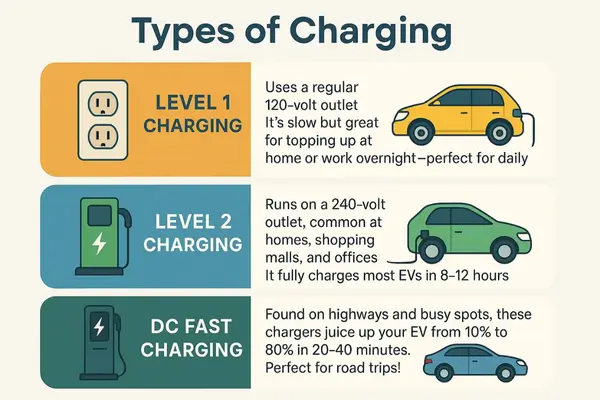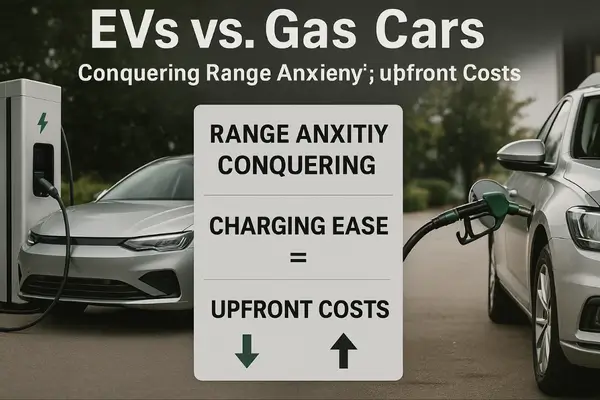Introduction:
Welcome to hstech.io, your go-to spot for the latest tech insights! and EVs vs. Gas Cars, Thinking about switching to an electric vehicle (EV)? You’re not alone! In 2025, EVs are gaining popularity, but questions like
- Will I run out of power on a trip?
- Are they too expensive?
Topics
Table of Contents
Often pop up. These worries, known as range anxiety, charging hassles, and high upfront costs, are real concerns, but the truth might surprise you. This guide breaks it all down with simple facts and tips, tailored for readers in the USA, UK, and beyond. Let’s explore EVs versus gas cars and see how they compare, so you can make an informed decision with confidence.
Tackling Range Anxiety: Is It a Real Worry?
Range anxiety—the fear of running out of battery mid-trip—can make EVs seem risky. But for most people, it’s not as big a deal as it sounds.
- Daily Driving Made Easy: The average person in the USA drives about 40 miles a day. Most EVs today offer 250+ miles per charge, covering a week’s worth of commuting and errands. Just plug in overnight at home—like charging your phone—and wake up with a “full tank”!
- Road Trips Simplified: For longer journeys, planning is your friend. Apps like A Better Route Planner or Google Maps display charging stations along your route. Break your trip into short legs with stops to charge and stretch, turning travel into an adventure.
In 2025, with EV ranges hitting 300-400 miles (e.g., Tesla Model Y), range anxiety is fading for daily and occasional long drives across the USA, UK, or Europe.
Charging Infrastructure: More Options Than Ever
Charging an EV used to feel like finding a needle in a haystack, but that’s no longer the case. The network is growing fast, thanks to global investments.
For more deails read this useful article: Electric Vehicles Demystified: The Ultimate easy Guide
Types of Charging
- Level 1 Charging: Uses a regular 120-volt outlet. It’s slow but great for topping up at home or work overnight—perfect for daily needs.
- Level 2 Charging: Operates on a 240-volt outlet, commonly found in homes, shopping malls, and offices. It fully charges most EVs in 8-12 hours, ideal for overnight use.
- DC Fast Charging: Found on highways and in busy areas, these chargers quickly charge your EV from 10% to 80% in 20-40 minutes. Perfect for road trips!

Why It’s Getting Easier
- Governments and companies (like Tesla and ChargePoint) are adding chargers everywhere. In the USA alone, over 150,000 public stations are expected to be live by 2025.
- Many EVs, such as the Ford Mustang Mach-E, feature built-in navigation to locate nearby chargers, making it stress-free whether you’re in London or Los Angeles.
Charging is becoming as convenient as filling up at a gas station—global trends show that a charger is within 20 miles for 90% of drivers.
The Real Cost of Electric Vehicles: More Than Just the Sticker Price
Yes, EVs often have a higher upfront cost than gas cars—sometimes $10,000 to $20,000 more. However, let’s take a look at the whole picture.
Long-Term Savings
- Fuel Costs: Electricity is cheaper than gas. In the USA, it costs about $0.04 per mile for an EV vs. $0.12 for a gas car (based on 2025 averages). That’s significant savings over time!
- Maintenance: EVs have fewer parts—no oil changes, no exhaust repairs. You might save $1,000 yearly compared to gas car upkeep.
- Incentives, such as tax credits (up to $7,500 in the USA) and rebates in the UK and EU, can significantly reduce the initial price. Check local offers on government sites!
Breaking It Down
Over the past decade, the total cost of an EV has often matched or beaten that of a gas car, especially with rising gas prices. For example, a $40,000 EV with incentives could save you $15,000 compared to a $30,000 gas car.

EVs vs Gas Cars: A Simple Comparison
| Feature | Electric Vehicle (EV) | Gas Car |
|---|---|---|
| Upfront Cost | Typically higher ($35,000-$60,000) | Typically lower ($25,000-$45,000) |
| Fuel Cost | Lower (electricity, ~$0.04/mile) | Higher (gas, ~$0.12/mile) |
| Maintenance | Lower (no oil changes) | Higher (regular tune-ups) |
| Range | 250-400 miles | 300-400 miles |
| Refueling | Slower (20-12 hrs or 20-40 min) | Faster (5-10 min) |
Frequently Asked Questions (FAQs)
Q1: How Long Does It Take to Charge an Electric Vehicle?
- A: It depends! Level 1 takes 12-24 hours to fully charge. Level 2 charging requires 8-12 hours, while DC fast charging reaches 80% in 20-40 minutes. Plan based on your drive!
Q2: Do EV Batteries Wear Out?
- A: Yes, but most last the car’s life (8-15 years). Warranties cover them for 8 years or 100,000 miles, so replacements are rare.
Q3: What About Battery Replacement Costs?
- A: A new battery can cost $5,000-$15,000, but it’s uncommon. With the improvement of technology and scale, costs are expected to drop—halving by 2030.
Q4: Can EVs Handle Cold Weather?
- A: Yes, but range may drop 10-20% in cold climates (e.g., UK winters or northern USA). Newer models with thermal systems minimize this.
Benefits of Choosing an Electric Vehicles
- Eco-Friendly: Zero emissions help fight climate change—big in the USA and EU green policies.
- Tech Perks: Features like over-the-air updates (e.g., Tesla) keep your car up to date.
- Resale Value: EVs are holding value better as demand grows.
Challenges to Consider
- Upfront cost remains a hurdle, although incentives help.
- Charging Time: Slower than gasoline, but fast chargers are addressing this issue.
- Limited Range: Not ideal for extreme off-grid trips yet.
Tips for Electric Vehicle Buyers
- Check Incentives: Visit usa.gov (USA) or gov.uk (UK) for local rebates.
- Test Drive: Feel the range and charging setup firsthand.
- Plan Charging: Install a home Level 2 charger or map public ones.
Future Outlook: Electric Vehicles in 2025 and Beyond
EV sales are expected to reach 15 million globally, according to IEA forecasts. Innovations such as solid-state batteries (promising over 500 miles) and faster chargers are on the horizon. Whether you’re in New York, London, or Berlin, the future of EVs is bright—stay informed!
Final Thoughts: Make the Switch with Confidence
EVs vs gas cars? It’s not just about range or cost—it’s about a smarter choice for your wallet and the planet. Range anxiety is manageable with planning; charging is becoming easier, and long-term savings outweigh the upfront cost. Ready to go electric? Start with a test drive and explore incentives. Share your thoughts or EV questions below—let’s chat! For more tech tips, visit hstech.io
Pingback: Christian Science reading room: Beliefs and 5 Amazing Queries